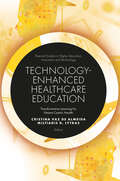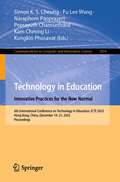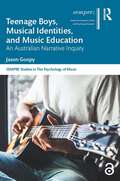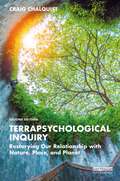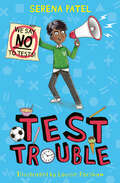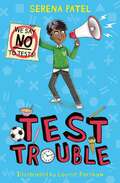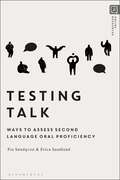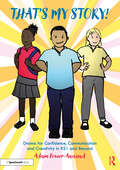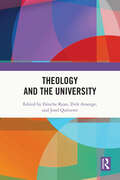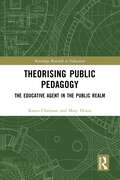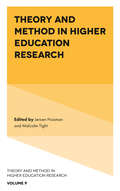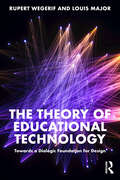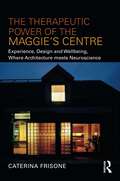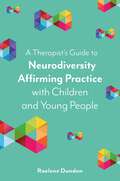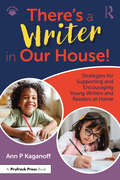- Table View
- List View
Technology-Enhanced Healthcare Education: Transformative Learning for Patient-Centric Health (Emerald Studies in Higher Education, Innovation and Technology)
by Cristina Vaz de Almeida and Miltiadis D. LytrasThe new challenges in healthcare education require new methodological approaches and transparent integration of technology enhanced learning approaches. Technology-Enhanced Healthcare Education promotes the best practices and lessons learnt from COVID-19 and highlights the importance and impact of using information systems to increase levels of health literacy. The chapter authors cover processes such as augmented or virtual reality to allow for distraction and decreased anxiety of the patient and services such as telemedicine and tele-consultation in the follow-up of non-acute patients. These are just a few ways in which health professionals can utilise information systems and transformative technology to increase the quality of health care, levels of health literacy and, thus, increase the health outcomes of their patients. Technology-Enhanced Healthcare Education is an innovative volume for health specialists, educators, higher education medical experts, medical school students and health management professionals. It is key reading for those looking to learn more about the latest developments on active and transformative learning within health education and medical technology (MedTech).
Technology-Enhanced Healthcare Education: Transformative Learning for Patient-Centric Health (Emerald Studies in Higher Education, Innovation and Technology)
by Cristina Vaz De Almeida Miltiadis D. LytrasThe new challenges in healthcare education require new methodological approaches and transparent integration of technology enhanced learning approaches. Technology-Enhanced Healthcare Education promotes the best practices and lessons learnt from COVID-19 and highlights the importance and impact of using information systems to increase levels of health literacy. The chapter authors cover processes such as augmented or virtual reality to allow for distraction and decreased anxiety of the patient and services such as telemedicine and tele-consultation in the follow-up of non-acute patients. These are just a few ways in which health professionals can utilise information systems and transformative technology to increase the quality of health care, levels of health literacy and, thus, increase the health outcomes of their patients. Technology-Enhanced Healthcare Education is an innovative volume for health specialists, educators, higher education medical experts, medical school students and health management professionals. It is key reading for those looking to learn more about the latest developments on active and transformative learning within health education and medical technology (MedTech).
Technology in Education. Innovative Practices for the New Normal: 6th International Conference on Technology in Education, ICTE 2023, Hong Kong, China, December 19–21, 2023, Proceedings (Communications in Computer and Information Science #1974)
by Simon K. S. Cheung Fu Lee Wang Naraphorn Paoprasert Peerayuth Charnsethikul Kam Cheong Li Kongkiti PhusavatThis book constitutes the refereed proceedings of the 6th International Conference on Technology in Education. Innovations for Online Teaching and Learning, ICTE 2023, held in Hong Kong, China, during December 19–21, 2023.The 30 full papers included in this book were carefully reviewed and selected from 74 submissions. They were organized in topical sections as follows: keynote papers; online and innovative learning; personalized and individualized learning; smart learning environment; artificial intelligence in education; and institutional strategies and practices.
Teenage Boys, Musical Identities, and Music Education: An Australian Narrative Inquiry (ISSN)
by Jason GoopyMusic is a powerful process and resource that can shape and support who we are and wish to be. The interaction between musical identities and learning music highlights school music education’s potential contributions and responsibilities, especially in supporting young people’s mental health and well-being. Through the distinctive stories and drawings of Aaron, Blake, Conor, Elijah, Michael, and Tyler, this book reveals the musical identities of teenage boys in their final year of study at an Australian boys’ school.This text serves as an interface between music, education, and psychology using narrative inquiry. Previous research in music education often seeks to generalise boys, whereas this study recognises and celebrates the diverse individual voices of students where music plays a significant role in their lives. Adolescent boys’ musical identities are examined using the theories of identity work and possible selves, and their underlying music values and uses are considered important guiding principles and motivating goals in their identity construction. A teaching and learning framework to shape and support multiple musical identities in senior secondary class music is presented.The relatable and personal stories in this book will appeal to a broad readership, including music teachers, teacher educators, researchers, and readers interested in the role of music in our lives. Creative and arts-based research methods, including narrative inquiry and innovative draw and tell interviews, will be particularly relevant for research method courses and postgraduate research students.
Teenage Boys, Musical Identities, and Music Education: An Australian Narrative Inquiry (ISSN)
by Jason GoopyMusic is a powerful process and resource that can shape and support who we are and wish to be. The interaction between musical identities and learning music highlights school music education’s potential contributions and responsibilities, especially in supporting young people’s mental health and well-being. Through the distinctive stories and drawings of Aaron, Blake, Conor, Elijah, Michael, and Tyler, this book reveals the musical identities of teenage boys in their final year of study at an Australian boys’ school.This text serves as an interface between music, education, and psychology using narrative inquiry. Previous research in music education often seeks to generalise boys, whereas this study recognises and celebrates the diverse individual voices of students where music plays a significant role in their lives. Adolescent boys’ musical identities are examined using the theories of identity work and possible selves, and their underlying music values and uses are considered important guiding principles and motivating goals in their identity construction. A teaching and learning framework to shape and support multiple musical identities in senior secondary class music is presented.The relatable and personal stories in this book will appeal to a broad readership, including music teachers, teacher educators, researchers, and readers interested in the role of music in our lives. Creative and arts-based research methods, including narrative inquiry and innovative draw and tell interviews, will be particularly relevant for research method courses and postgraduate research students.
Terrapsychological Inquiry: Restorying Our Relationship with Nature, Place, and Planet
by Craig ChalquistTerrapsychological Inquiry is a path of storied, imaginative research that takes seriously our intense inner responses to the state of the natural world. This place-rooted approach studies, from the standpoint of lived experience, how the world gets into the heart. Oceans and skies, trees and hills, rivers and soils, and even built things like houses, cities, ports, and planes: How do they show up for us inwardly? How do our moods, feelings, and dreams reflect what happens in the world? Terrapsychological Inquiry evolved over a decade of exploration by graduate students, instructors, ceremonialists, workshop leaders and presenters, and other practitioners of embodied creativity to offer an Earth-honoring mode of storied qualitative inquiry, one that transforms all involved from passive spectators of the doings of the world into active, sensitive participants. Learn how to use this methodology of earthly reenchantment in a variety of settings inside and outside academia and by doing so reenter an animate world. This new edition has been revised throughout and offers fresh insights into how Terrapsychological Inquiry, a field with roots in depth psychology, ecopsychology, and Hermetic philosophy, can also be used as an ecospiritual path. Thoroughly updated with a new chapter and added discussion questions and exercises at the end of each chapter, this introduction to an evolving research methodology will be of great interest to students and scholars of environmental psychology, ecotherapy, and environment and sustainability studies more generally.
Terrapsychological Inquiry: Restorying Our Relationship with Nature, Place, and Planet
by Craig ChalquistTerrapsychological Inquiry is a path of storied, imaginative research that takes seriously our intense inner responses to the state of the natural world. This place-rooted approach studies, from the standpoint of lived experience, how the world gets into the heart. Oceans and skies, trees and hills, rivers and soils, and even built things like houses, cities, ports, and planes: How do they show up for us inwardly? How do our moods, feelings, and dreams reflect what happens in the world? Terrapsychological Inquiry evolved over a decade of exploration by graduate students, instructors, ceremonialists, workshop leaders and presenters, and other practitioners of embodied creativity to offer an Earth-honoring mode of storied qualitative inquiry, one that transforms all involved from passive spectators of the doings of the world into active, sensitive participants. Learn how to use this methodology of earthly reenchantment in a variety of settings inside and outside academia and by doing so reenter an animate world. This new edition has been revised throughout and offers fresh insights into how Terrapsychological Inquiry, a field with roots in depth psychology, ecopsychology, and Hermetic philosophy, can also be used as an ecospiritual path. Thoroughly updated with a new chapter and added discussion questions and exercises at the end of each chapter, this introduction to an evolving research methodology will be of great interest to students and scholars of environmental psychology, ecotherapy, and environment and sustainability studies more generally.
Test Trouble
by Serena PatelTry as he might, Arun simply cannot wriggle his way out of taking the maths test at school. Instead, he must learn to face his fears in this encouraging and relatable school story from Serena Patel.
Testing Talk: Ways to Assess Second Language Oral Proficiency
by Dr Pia Sundqvist Dr Erica SandlundOral assessments are of vital importance to second language learners, but how can teachers and examiners best test L2 learner talk and interaction? Bringing together theory and research within the field of L2 oral proficiency, with the concept of L2 encompassing any language learned later than the early childhood years, this book provides a state-of-the art overview of what is at stake for L2 learners and examiners, and advice on how to approach testing and assessment. Using data and findings from empirical research to illustrate and discuss key topics, Testing Talk takes the reader step-by-step through the major concepts and issues in the oral assessment of second languages, with a main focus on L2 English. Investigating and explaining the most important educational and interactional issues facing both examiners and test-takers, such as the factors which come into play during speaking tests, the differences between common test formats, and the challenge of ensuring equity in assessment, this book offers research-based advice on ways to design test tasks and in-depth insights into the assessment of L2 speaking. Featuring a glossary of key terms and concepts, discussion questions and further reading for each chapter, and a comprehensive companion website hosting a wealth of additional materials, including authentic test recordings and assessment tasks to be used by researchers and practitioners alike, this is the only book needed in order to understand, design, and assess interactive oral L2 tests.
That's My Story!: Drama for Confidence, Communication and Creativity in KS1 and Beyond
by Adam Power-AnnandThe ability to communicate is an essential life skill for all children and young people and it underpins their social, emotional and educational development. If a child experiences a positive relationship with an adult listening carefully, they are more likely to constructively share their thoughts, feelings and their imaginative ideas.That’s My Story! places children’s imagined stories at the heart of their own development and provides a joyful, creative approach to support young children’s personal and social development and to encourage their communication. In this book you will find: Tried-and-tested drama games and activities that support communication and well-being, all adaptable to complement your current practice Guidance and advice on how to promote positive adult-child interactions Examples of creative interventions that support children’s communication development A celebration of the joy that comes with carefully listening to children’s own imagined stories Those of us who work with children can sense a tangible connection between how young children feel and how they communicate. This essential and practical resource will be valuable reading for primary teachers, teaching assistants, speech and language therapists, and drama practitioners, as well as outreach and education departments of theatre companies and other arts organisations.
That's My Story!: Drama for Confidence, Communication and Creativity in KS1 and Beyond
by Adam Power-AnnandThe ability to communicate is an essential life skill for all children and young people and it underpins their social, emotional and educational development. If a child experiences a positive relationship with an adult listening carefully, they are more likely to constructively share their thoughts, feelings and their imaginative ideas.That’s My Story! places children’s imagined stories at the heart of their own development and provides a joyful, creative approach to support young children’s personal and social development and to encourage their communication. In this book you will find: Tried-and-tested drama games and activities that support communication and well-being, all adaptable to complement your current practice Guidance and advice on how to promote positive adult-child interactions Examples of creative interventions that support children’s communication development A celebration of the joy that comes with carefully listening to children’s own imagined stories Those of us who work with children can sense a tangible connection between how young children feel and how they communicate. This essential and practical resource will be valuable reading for primary teachers, teaching assistants, speech and language therapists, and drama practitioners, as well as outreach and education departments of theatre companies and other arts organisations.
Theology and the University
by Fáinche Ryan Dirk Ansorge Josef QuittererTheology and the University presents a compelling argument as to why theology still matters. It considers how theology has been marginalised in the academy and in public life, arguing that doing so has serious repercussions for the integrity of the academic study of religion.The chapters in this book demonstrate how theology, as the only discipline which represents religion from within, provides insight into aspects of religion which are hidden from the social sciences. Against a backdrop of heated debates on the role of the humanities in the university, the book highlights the specific contribution of theological education and research to the work of a university, providing essential information for academic and social/political decision-making. Whilst the book has an emphasis on the Catholic tradition, it explores the prospect of fruitful complementarity and interdisciplinarity both with secularised studies of religion, and other disciplines in the university, such as literature, philosophy, and the social sciences.This book provides orientation for decision-makers, particularly those concerned with the broader question of humanities in the university; students in their choice of study; those interested in the wellbeing of today’s universities; and ecclesial authorities seeking to form leaders capable of intelligent responses to the issues of contemporary society. It is a must read for all researchers of theology, as well as anyone interested in the role of the humanities more broadly.
Theology and the University
Theology and the University presents a compelling argument as to why theology still matters. It considers how theology has been marginalised in the academy and in public life, arguing that doing so has serious repercussions for the integrity of the academic study of religion.The chapters in this book demonstrate how theology, as the only discipline which represents religion from within, provides insight into aspects of religion which are hidden from the social sciences. Against a backdrop of heated debates on the role of the humanities in the university, the book highlights the specific contribution of theological education and research to the work of a university, providing essential information for academic and social/political decision-making. Whilst the book has an emphasis on the Catholic tradition, it explores the prospect of fruitful complementarity and interdisciplinarity both with secularised studies of religion, and other disciplines in the university, such as literature, philosophy, and the social sciences.This book provides orientation for decision-makers, particularly those concerned with the broader question of humanities in the university; students in their choice of study; those interested in the wellbeing of today’s universities; and ecclesial authorities seeking to form leaders capable of intelligent responses to the issues of contemporary society. It is a must read for all researchers of theology, as well as anyone interested in the role of the humanities more broadly.
Theorie beruflicher Didaktik: Philosophische Reflexionen und pädagogische Perspektiven (Pädagogik)
by Ruben Tecklenburg-RapskeWie kann das Fundament einer Theorie beruflicher Didaktik aussehen, die den Anspruch der Prozessorientierung in aller Tiefe und Breite aufnimmt? Ruben Tecklenburg-Rapske verknüpft zentrale Ansätze der Philosophie, Bildungstheorie und Didaktik. Er entwickelt so miteinander verzahnte, modellhafte Vorschläge, die bestehende theoretische Grundlagen ergänzen oder ersetzen. Die pädagogisch didaktische Theorie wird dadurch als eigenständig erfahrungsbezogener Zusammenhang von Begriffen, Urteilen und Schlüssen fassbar, in dem komplexe Themen und Fragen der Berufspädagogik neu diskutierbar sind.
Theorising Public Pedagogy: The Educative Agent in the Public Realm (Routledge Research in Education)
by Karen Charman Mary DixonDrawing on the ideas of Hannah Arendt and Michel Foucault, this book extends the theoretical understanding of public pedagogy and brings into sharp focus the elements that constitute the public realm; the site of public pedagogy. Karen Charman and Mary Dixon offer a new theorisation of the public, a term at the heart of debate in the field, heightened in this post-truth era by the COVID-19 pandemic, the rise of fake news and the technological reconfigurations of public life. The new theorization addresses the ‘public’, ‘pedagogy’ and their confluence in ‘public pedagogy’. The book explores a deep engagement with the architecture and dynamics of pedagogy and argues for the positioning of pedagogy with the public. The authors contribute to a theorisation that re-considers the individual and their capacity for agency within the public realm. The book presents knowledge and pedagogical encounters as key elements of public pedagogy and most significantly, the educative agent as a means of critically rethinking social life and learning in public spaces. Presenting an innovative theoretical approach, this book will be of interest to academics in the fields of public and critical pedagogy and postgraduate students in education, cultural studies and politics.
Theorising Public Pedagogy: The Educative Agent in the Public Realm (Routledge Research in Education)
by Karen Charman Mary DixonDrawing on the ideas of Hannah Arendt and Michel Foucault, this book extends the theoretical understanding of public pedagogy and brings into sharp focus the elements that constitute the public realm; the site of public pedagogy. Karen Charman and Mary Dixon offer a new theorisation of the public, a term at the heart of debate in the field, heightened in this post-truth era by the COVID-19 pandemic, the rise of fake news and the technological reconfigurations of public life. The new theorization addresses the ‘public’, ‘pedagogy’ and their confluence in ‘public pedagogy’. The book explores a deep engagement with the architecture and dynamics of pedagogy and argues for the positioning of pedagogy with the public. The authors contribute to a theorisation that re-considers the individual and their capacity for agency within the public realm. The book presents knowledge and pedagogical encounters as key elements of public pedagogy and most significantly, the educative agent as a means of critically rethinking social life and learning in public spaces. Presenting an innovative theoretical approach, this book will be of interest to academics in the fields of public and critical pedagogy and postgraduate students in education, cultural studies and politics.
Theory and Method in Higher Education Research (Theory and Method in Higher Education Research #9)
by JEROEN HUISMAN AND MALCOLM TIGHTHigher education research is a developing field internationally, which is attracting more and more researchers from a great variety of disciplinary backgrounds within and beyond higher education institutions. As such, it is an arena within which a wide range of theories, methods and methodologies is being applied. This volume of Theory and Method in Higher Education Research explores theories such as student development theory, critical race theory applied to international students, critical language theory and linguistic approaches to higher education research. Additionally, methodological contributions include chapters on quasi-experimental methods, arts-based research and reflective dialogues. Including contributors from Sweden, Finland, Japan, the US, and the UK, the chapter authors present international perspectives on the application and development of theory and methodology in researching higher education.
Theory and Method in Higher Education Research (Theory and Method in Higher Education Research #9)
by Jeroen Huisman Malcolm TightHigher education research is a developing field internationally, which is attracting more and more researchers from a great variety of disciplinary backgrounds within and beyond higher education institutions. As such, it is an arena within which a wide range of theories, methods and methodologies is being applied. This volume of Theory and Method in Higher Education Research explores theories such as student development theory, critical race theory applied to international students, critical language theory and linguistic approaches to higher education research. Additionally, methodological contributions include chapters on quasi-experimental methods, arts-based research and reflective dialogues. Including contributors from Sweden, Finland, Japan, the US, and the UK, the chapter authors present international perspectives on the application and development of theory and methodology in researching higher education.
The Theory of Educational Technology: Towards a Dialogic Foundation for Design
by Rupert Wegerif Louis MajorEducational technology is controversial – some see it as essential to providing free global learning, others view it as a dangerous distraction that undermines good education. In both instances, most theories that have previously been applied to educational technology do not account for the distinctive nature and vast potential of technology. This book addresses this issue, exploring how education has been bound up with technology from the beginning, and recognising that educational aims have already been shaped by technologies. Offering a ‘dialogic’ theory of educational technology, Rupert Wegerif and Louis Major respond to contemporary challenges to education within this book, including, but not limited to, climate change, misinformation on the internet and the impact of Artificial Intelligence. Chapters introduce, discuss, and contextualise key theories and illustrate through case studies their uses within a diverse range of educational contexts, spanning from primary education to adult lifelong learning. Each chapter also concludes with a short summary, demonstrating how these theories translate to practical implications for design. A fascinating response to current developments in educational technology, this is a crucial read for all involved in creating, researching or making decisions about the use of technologies within educational contexts.
The Theory of Educational Technology: Towards a Dialogic Foundation for Design
by Rupert Wegerif Louis MajorEducational technology is controversial – some see it as essential to providing free global learning, others view it as a dangerous distraction that undermines good education. In both instances, most theories that have previously been applied to educational technology do not account for the distinctive nature and vast potential of technology. This book addresses this issue, exploring how education has been bound up with technology from the beginning, and recognising that educational aims have already been shaped by technologies. Offering a ‘dialogic’ theory of educational technology, Rupert Wegerif and Louis Major respond to contemporary challenges to education within this book, including, but not limited to, climate change, misinformation on the internet and the impact of Artificial Intelligence. Chapters introduce, discuss, and contextualise key theories and illustrate through case studies their uses within a diverse range of educational contexts, spanning from primary education to adult lifelong learning. Each chapter also concludes with a short summary, demonstrating how these theories translate to practical implications for design. A fascinating response to current developments in educational technology, this is a crucial read for all involved in creating, researching or making decisions about the use of technologies within educational contexts.
The Therapeutic Power of the Maggie’s Centre: Experience, Design and Wellbeing, Where Architecture meets Neuroscience
by Caterina FrisoneThis book is about the therapeutic environment of the Maggie’s centre and explores the many ways this is achieved. With an unconventional architecture as required by the design brief, combined with Maggie’s psychological support programme, this special health facility allows extraordinary therapeutic effects in people, to the point that one can speak of therapeutic power.After tracing the story of the Maggie’s centre, the book reveals its fundamentals: Maggie’s Therapeutikos (the-mind-as-important-as-the-body), the Architectural Brief and the ‘Client-Architect-Users’ Triad. It continues by unfolding Maggie’s synergy-that between people and place-which increases users’ psychological flexibility helping them tolerate what was intolerable before. Although comfort and atmospheres are paramount, they are not enough to define the therapeutic environment of the Maggie’s centre. Only by looking at neuroscience that can give us scientific explanations of empathy, feelings and emotions and only considering space neither neutral nor empty, but full of forces that envelop people in an embodied experience, can we explain what generates wellbeing in a Maggie’s centre.The book concludes by critically evaluating the Maggie’s centre as a model to be applied to other healthcare facilities and to architecture in general. It is essential reading for any student or professional working on therapeutic environments.
The Therapeutic Power of the Maggie’s Centre: Experience, Design and Wellbeing, Where Architecture meets Neuroscience
by Caterina FrisoneThis book is about the therapeutic environment of the Maggie’s centre and explores the many ways this is achieved. With an unconventional architecture as required by the design brief, combined with Maggie’s psychological support programme, this special health facility allows extraordinary therapeutic effects in people, to the point that one can speak of therapeutic power.After tracing the story of the Maggie’s centre, the book reveals its fundamentals: Maggie’s Therapeutikos (the-mind-as-important-as-the-body), the Architectural Brief and the ‘Client-Architect-Users’ Triad. It continues by unfolding Maggie’s synergy-that between people and place-which increases users’ psychological flexibility helping them tolerate what was intolerable before. Although comfort and atmospheres are paramount, they are not enough to define the therapeutic environment of the Maggie’s centre. Only by looking at neuroscience that can give us scientific explanations of empathy, feelings and emotions and only considering space neither neutral nor empty, but full of forces that envelop people in an embodied experience, can we explain what generates wellbeing in a Maggie’s centre.The book concludes by critically evaluating the Maggie’s centre as a model to be applied to other healthcare facilities and to architecture in general. It is essential reading for any student or professional working on therapeutic environments.
A Therapist’s Guide to Neurodiversity Affirming Practice with Children and Young People
by Raelene DundonIn this honest and practical guide, autistic therapist Raelene Dundon explores and demystifies how neurodiversity affirming principles can be easily applied to therapeutic practice.Covering essential considerations for working with neurodivergent clients such as presuming competence, promoting autonomy and respecting communication styles, and providing advice on the best affirming approaches in therapy including how to accommodate sensory needs and encourage self-advocacy, Raelene provides easy-to-implement ways to make your practice inclusive and empowering for neurodivergent children and young people.The deficit model is out. It's time to become neurodiversity affirming.
There's a Writer in Our House! Strategies for Supporting and Encouraging Young Writers and Readers at Home
by Ann P. KaganoffThere’s a Writer in Our House! is an invitation to parents of children in first grade through fifth grade interested in actively participating in their children’s early literacy learning from the very first steps.Founded upon well-researched literacy instructional methods that have been informed by the author’s clinical perspective as well as her years of experience with many kinds of learners, this book provides a valuable understanding of how both writing and reading contribute to child development in multiple areas. Chapters provide background concepts regarding grammar and specific critical thinking skills in both writing and reading as well as customizable, child-centered activities used to practice and build writing and reading comprehension skills.You will learn how to advance and encourage your child’s learning and communication skills by highlighting important literacy areas such as vocabulary development, background knowledge, and critical thinking. You will also learn to recognize and track the significant developmental achievements of your child as you proceed from the early to the more complex At-Home activities, as well as receive strategies for how to respond and give feedback in specific situations, such as when a child writes something that makes sense to the child but not to the parent, how to offer feedback that identifies and labels a child’s strengths, and how to collaborate effectively with a child who is just developing new interests or a new willingness to try something that previously seemed “hard.”Practical, accessible, and most importantly, fun, this book is a must-read for all parents, regardless of background, seeking to support their children’s ongoing literacy development confidently and effectively.
